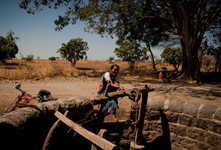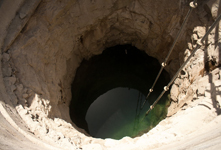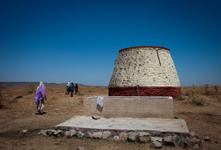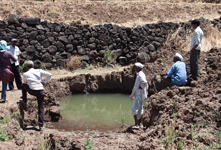Securing drinking water in Maharashtra villages

Maharashtra until recently was reeling under a drought situation the worst in the last 40 years. The state declared drought in 125 out of 358 talukas during kharif 2012, followed by declaring water scarcity in 3,905 villages in Rabi 2012-13.
Arghyam, a public charitable foundation working in the drinking water and sanitation sector since 2005, funded two NGOsto secure drinking water in six villages of Maharashtra during the drought
These villages are Thapewadi and Falakewadi in Pune, Muthalane and Randulabad in Satara, and Satichiwadi and Shelkewadi villages in Ahmednagar. Two years after completion, evidence on the ground suggests that the interventions continue to remain successful in the six villages. All six villages lie in the rain shadow area and the key to the achievement of securing drinking water resources was community participation, says Ayan Biswas of Arghyam, a Sanskrit word meaning Offering.
The communities realised that in conditions of scanty or severely deficient rain, a careful and rational use of water can turn the critical situation for better.
The community recognised water as a common pool resource, which enabled water needs of different groups to be balanced in a fair and equitable manner.
 The community adopted organised approaches like monitoring water availability throughout the year and across seasons, judicious distribution across water for drinking, cattle and agriculture, and choosing crops based on water availability.
The community adopted organised approaches like monitoring water availability throughout the year and across seasons, judicious distribution across water for drinking, cattle and agriculture, and choosing crops based on water availability.
Metering water supply and assigning a price to water consumed was an effective way of conserving and valuing limited sources of water. In the village of Falakewadi (in Pune district), where meters were introduced in homes, household consumption of water reduced without hampering basic needs. Water tariffs were fixed in an entirely participatory process.
Falakewadi, even in times of scant rainfall has enough water to drink, whereas the neighbouring villages rely heavily on water tankers. During periods of drought, social-regulation played a key role in ensuring supply of potable water. The water committee of Thapewadi village (in Pune District) now regulates the number of hours of water supply to each settlement based on water budgeting tools. When well water levels were falling, the inhabitants of Satichiwadi (in Ahmednagar district) agreed to minimise water use for Rabi crops.
The interventions in the six villages were facilitated by two NGOs Watershed Organisation Trust (WOTR) and Advanced Center for Water Resources Development and Management (ACWADAM).
 WOTR founded in 1993 is operating in five 6 Indian states – Maharashtra, Andhra Pradesh, Madhya Pradesh, Rajasthan, Jharkhand, and Orissa. It is widely recognised as a premier institution in the field of participatory Watershed Development and Climate Change Adaptation.
WOTR founded in 1993 is operating in five 6 Indian states – Maharashtra, Andhra Pradesh, Madhya Pradesh, Rajasthan, Jharkhand, and Orissa. It is widely recognised as a premier institution in the field of participatory Watershed Development and Climate Change Adaptation.
CWADAM is another premier Education and Research Institution that facilitates work on groundwater management through action research programmes and trainings. While, WOTRs approach to water security was through the implementation of large-scale watersheds,ACWADAMs strategy was to improve supply augmentation through understanding of hydrogeology, community driven water balance, demand regulation and management of groundwater through common pool resource principles. Their interventions for drinking water security in the six villages have been built on the earlier work done by both the NGOs. The approaches to water security were complimented with newer approaches of strengthening village level institutions, building capacities within the communities and deepening local leadership. The partner NGOs were able to leverage and augment the public drinking water infrastructure in these villages.
 Today, water stand-posts are uniformly distributed in these villages. The revival and construction of piped water supply has considerably reduced the drudgery of women. They now have more time for their children and their households. Women in these six villages have also become more active in their water committees.
Today, water stand-posts are uniformly distributed in these villages. The revival and construction of piped water supply has considerably reduced the drudgery of women. They now have more time for their children and their households. Women in these six villages have also become more active in their water committees.
In the drought of 2003 women had to walk 2-3 km to fetch water from irrigation wells after the drinking water source dried up. Tankers used to come to the village and empty the water in the wells. WOTR helped us recharge the bore-well that supplies water to the village. Today, we have enough drinking water even in these days of drought, while the neighbouring villages of Pimplagaon and Pabalbet get tanker water or canned water at exorbitant costs, says Sharada Ghavani from Thapewadi village.
These six villages have shown that by systematic planning of local water resources, participatory decision making, and self-regulation, drinking water can be secured even during drought situation. The intervention in these villages has demonstrated that safe and sustainable drinking water for all can easily be a reality for other parts of the country with similar climatic conditions and propensity for drought. This is a writeup by Syed Ali Mujtaba is a journalist based in Chennai. He can be contacted at syedalimujtaba@yahoo.com.
For further information on the story, please contact Ayan Biswas at: ayan@arghyam.org (080)41698941/42More : Articles on India